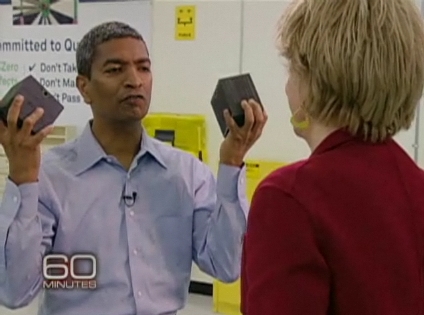The internet loves mysterious product unveilings, especially those promising to revolutionize the world and how we live in it. (Think Apple’s iPhone.) But few (except for maybe the iPhone) actually live up to the hype. (Or so I hear. Anyone wanna get me an iPhone?)
 CEO K.R. Sridhar is starting to peel back the layers of secrecy from his magic boxes like a Bloomin’ onion.
CEO K.R. Sridhar is starting to peel back the layers of secrecy from his magic boxes like a Bloomin’ onion.
Now, after nearly a decade of secrecy, Bloom Energy CEO K.R. Sridhar is coming out of the shadows to tell the world how his “Bloom Box” will do all of this and more as a “zero-emissions” mini-power plant. Bloom Energy debuted its heady energy dreams in an exclusive interview on 60 Minutes this past Sunday, with the company’s official launch to come on Wednesday at early customer eBay’s California headquarters. Google, Wal-Mart, and FedEx have also been quietly testing these heavily-subsidized magic boxes on their premises, with encouraging energy and cost savings thus far.
But, zero emissions? A backyard power plant-in-a-box? Sounds fancy, but what is a Bloom Box and is it really the next “energy breakthrough”?
The Bloom Box is a fuel cell, not an energy source.
According to CBS, it’s “a new kind of fuel cell, which is like a very skinny battery that always runs. Sridhar feeds oxygen to it on one side, and fuel on the other. The two combine within the cell to create a chemical reaction that produces electricity. There’s no need for burning or combustion, and no need for power lines from an outside source.”
But the box still requires a fuel source, which 60 Minutes interviewer Lesley Stahl glosses over in a few sentences:
To make power, you’d still need fuel. Many past fuel cells failed because they needed expensive pure hydrogen. Not this box.
“Our system can use fossil fuels like natural gas. Our system can use renewable fuels like landfill gas, bio-gas,” Sridhar told Stahl. “We can use solar.”
CNN’s Fortune Brainstorm blog explains things a little better:
“Hydrocarbons such as natural gas or biofuel (stored in an adjacent tank) are pumped into the Bloom Box — ceramic plates stacked atop each other to form modules that can be assembled into a unit of any size — and out comes abundant, reliable, cleaner electricity.”
UPDATE: The original quote by the Christian Science Monitor incorrectly tried to explain how the Bloom Box might use renewable vs. fossil fuels. CO2 would not be emitted from “whatever power plant is feeding the Bloom Box,” but instead, would be a by-product of the methane fuel feeding it (whether it’s from natural gas or landfill gas). Fuel could not (and should not) come directly from solar or wind, because that’s an inefficient use of electricity, which is difficult to store and should be used immediately. The “zero emissions” claim only holds up in the same way that biofuels take CO2 out of the system upstream. Bloom Boxes would likely be using natural gas most of the time, which is far from zero emissions.
Venture capitol blog VentureBeat hones in on some of the more interesting points about this invention:
“Right now, it’s available on a large scale, with each box costing as much as $800,000. In the next five to ten years, Bloom says it will release smaller boxes for individual households costing less than $3,000. If this happens, there is a chance that Bloom Boxes could [supplant] utilities and long-distance transmission lines — not to mention capital intensive wind farms and solar arrays.”
I could imagine these boxes perhaps replacing million-dollar-a-mile transmission lines, but I doubt the Bloom Box will electrify the power industry if it’s supposedly replacing many of the clean energy sources it would require for fuel.
And with this list of 10 Fuel Cell Startups Hot On Bloom Energy’s Trail, Earth2Tech emphasizes that Bloom isn’t the only company out there trying to master fuel cell technology: “In fact, stationary fuel cells — devices that chemically convert hydrogen into electricity and water, or hydrogen-containing fuels into power, water and various byproducts — are already a highly-populated industry.”
Here’s the best analogy I’ve come up with for the potential of the Bloom Box: It isn’t the internet; that would be the fuel, which may or may not be renewable. The Bloom Box is more akin to the wireless router — rather than the dial-up modem — that gets the internet to your laptop (aka your house). But right now it’s one heck of a pricey router.
Watch the 60 Minutes interview with Lesley Stahl:



